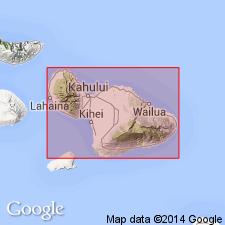
- Usage in publication:
-
- Wailuku volcanic series*
- Modifications:
-
- Named
- Dominant lithology:
-
- Basalt
- AAPG geologic province:
-
- Maui
Summary:
Named for town of Wailuku. Type locality is 3,500 ft elevation, southern wall of Iao Valley [20 deg 54' 36"N, 156 deg 29' 24"W, Wailuku 7.5' quad]. Exposed at surface of most of Western Maui and in deep canyons. Composed of olivine basalts. At type is thin-bedded pahoehoe and aa beds. In cliffs thin beds weather to dark gray, red, red violet, and brown. Individual flows range from 1 to 100 ft thick. Stratigraphic chart gives total thickness of these flows as 5,500+ ft. Base is not exposed. Separated from overlying Honolua volcanic series (new) by thin, red soil, locally tuffaceous. Map assigns probably Pliocene and early and middle Pleistocene age.
Source: GNU records (USGS DDS-6; Menlo GNULEX).
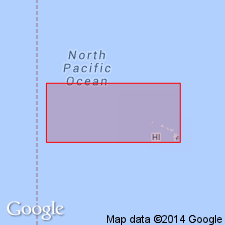
- Usage in publication:
-
- Wailuku volcanic series*
- Modifications:
-
- Age modified
- AAPG geologic province:
-
- Maui
Summary:
Assigned Pliocene(?) age based on degree of weathering and erosion.
Source: GNU records (USGS DDS-6; Menlo GNULEX).
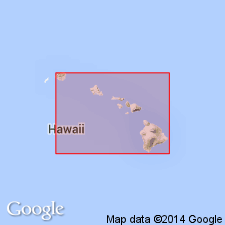
- Usage in publication:
-
- Wailuku volcanic series*
- Modifications:
-
- Geochronologic dating
- AAPG geologic province:
-
- Maui
Summary:
K-Ar ages on olivine basalt from Wailuku volcanic series (N coast of W Maui) range from 1.32 to 1.27 Ma.
Source: GNU records (USGS DDS-6; Menlo GNULEX).
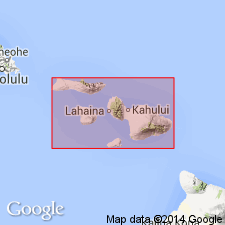
- Usage in publication:
-
- Wailuku Volcanic Series*
- Modifications:
-
- Geochronologic dating
- AAPG geologic province:
-
- Maui
Summary:
K-Ar ages on tholeiite pahoehoe and aa from Wailuku Volcanic Series (on Olawalu Stream, Island of Maui) range from 1.97 +/-0.96 to 1.58 +/-0.39 Ma.
Source: GNU records (USGS DDS-6; Menlo GNULEX).
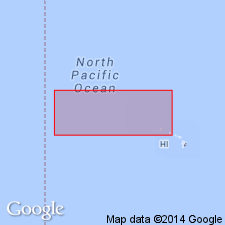
- Usage in publication:
-
- Wailuku Formation
- Modifications:
-
- Revised
- AAPG geologic province:
-
- Maui
Summary:
Wailuku Volcanic Series of Stearns and Macdonald (1942) reduced in rank and renamed Wailuku Formation. "Following the usage of Macdonald (1978), most volcanic series have been renamed as formations." (p.2)
Source: GNU records (USGS DDS-6; Menlo GNULEX).
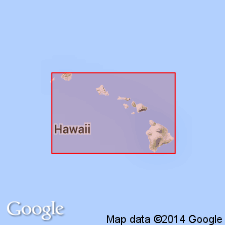
- Usage in publication:
-
- Wailuku Basalt*
- Modifications:
-
- Revised
- AAPG geologic province:
-
- Maui
Summary:
Wailuku Volcanic Series of Stearns and Macdonald (1942) reduced in rank and renamed Wailuku Basalt, in accordance with 1983 Code of Stratigraphic Nomenclature, and to indicate lithology.
Source: GNU records (USGS DDS-6; Menlo GNULEX).
For more information, please contact Nancy Stamm, Geologic Names Committee Secretary.
Asterisk (*) indicates published by U.S. Geological Survey authors.
"No current usage" (†) implies that a name has been abandoned or has fallen into disuse. Former usage and, if known, replacement name given in parentheses ( ).
Slash (/) indicates name conflicts with nomenclatural guidelines (CSN, 1933; ACSN, 1961, 1970; NACSN, 1983, 2005, 2021). May be explained within brackets ([ ]).

